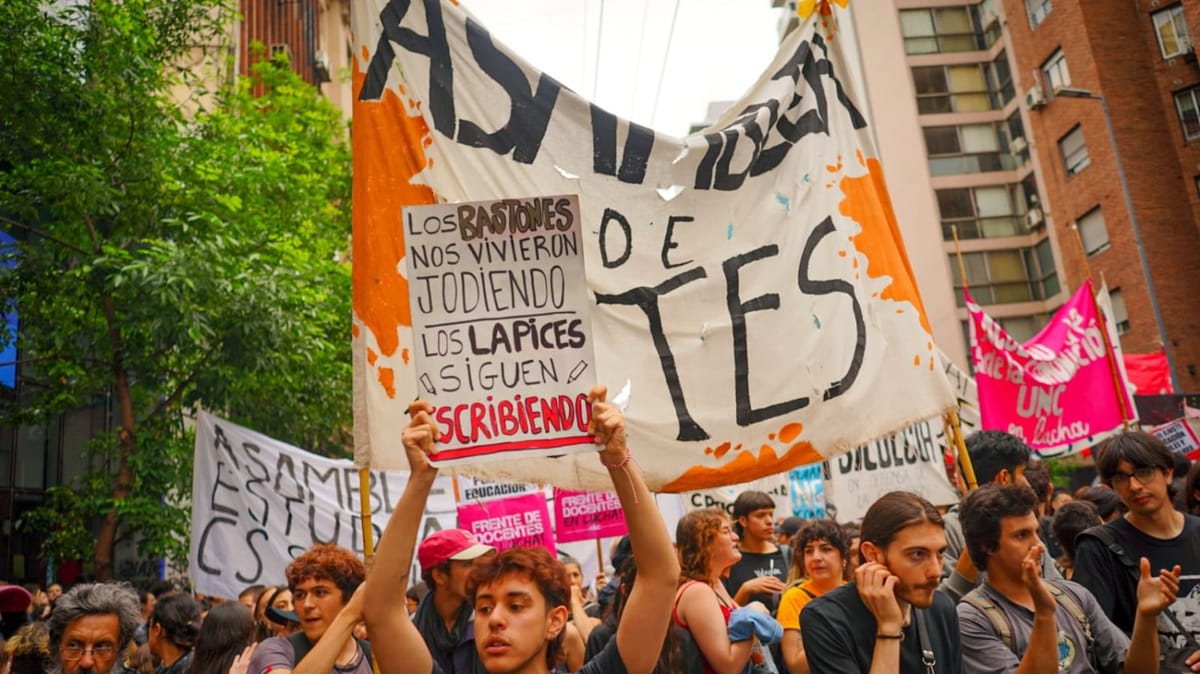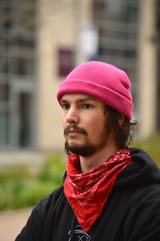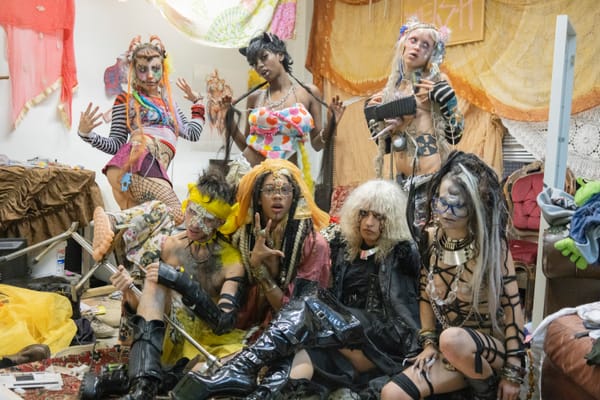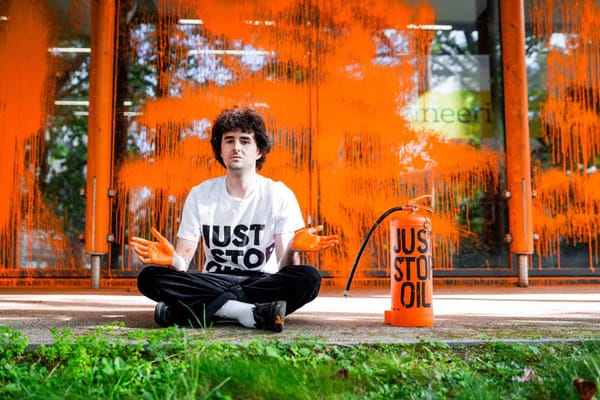In Argentina, Students are Leading Resistance to Milei

After protesting all year, students have set an example for the rest of Argentina – and hope they can bring the country with them.
When you Google the president of a country, “chainsaw wielding” is not a phrase you expect to see. Yet this is by far the most common description I read describing Javier Milei – Argentina’s far-right President who has been in power for a year. The former TV pundit is a self described anarcho-capitalist who claims to have been urged to run for office by his dead dog’s spirit. During the campaign he garnered attention with eccentric public appearances like unveiling his superhero alter-ego, General Ancap, waving a chainsaw around at rallies and making controversial pledges like promising to legalise the sale of human organs.
Like Trump, or Boris Johnson, he’s easy to laugh at, until you confront the reality of his Presidency. His solution to Argentina’s spiralling inflation is a program of extreme libertarianism. In his first week Milei dissolved 9 of the 18 government ministries by merging them in cost cutting efforts. Since then he’s slashed subsidies for transport, fuel and energy, laid off thousands of public employees and passed a large decree dubbed the "Megadecreto". In it, Milei made sweeping changes to over 300 regulations, including significant renters' and workers’ protections and made certain forms of protest like blocking roads illegal. According to the government’s National Institute of Statistics and Census, Argentina’s health, pension and education spending have been hit particularly hard by cuts. 53% of Argentinians are now living in poverty and at the start of November inflation was still among the world’s highest at 209%.
There are very few, if any, areas of Argentinian life that remain unscathed but despite this, Milei’s Presidency has been met with surprisingly little resistance. There have been some demonstrations, a one-day general strike and small protests here and there, but nothing on the society-wide scale you might expect in response to a President savagely tearing apart public services.
“So far it's been pretty tepid,” says Fede, a games designer based in the capital, Buenos Aires, “that's one of those things a lot of people against Milei are constantly talking about. They are surprised by the lack of popular response and intensity.” But that tepidity is changing and cracks have begun to show in Milei’s administration.
Argentina’s public university system is a source of pride for many Argentinians. The system is considered one of the best in Latin America, offering undergraduate courses to anyone, even foreign students, for free. "Most of us choose to go to public universities because they are really good, they are highly ranked in international rankings … they are renowned around the world," explained one student leader who asked to remain anonymous, "it means a more equitable society, a more just society … many of us who attend public universities choose to, we don't just go there because we cannot afford private college. All of us, no matter how much money we have or where we were born, we all learn with the same materials, with the same professors and the same classes."
According to La Izquierda Diario, student numbers at public universities have doubled in the last three decades, making the student movement larger and far more working-class. Public university enrolment more than doubled from 28 universities with 600,000 students in 1990, to 61 universities with 2 million students today. Importantly, the lack of tuition fees has allowed this expansion to be fuelled by working class students’ enrolment. 47.8% of students are first-generation students coming from working-class backgrounds – at some universities this number rises as high as 75%.
Milei meanwhile argues public universities indoctrinate the youth into socialism and painted higher education as a middle-class indulgence, declaring: “The national public university does not serve anyone other than the children of the rich and the upper and upper middle class, in a country where the great majority of children are poor.”
The government had threatened to privatise universities, “but with the social pressure they said they couldn't” said Ana, a Masters student studying political analysis and member of the Trotskyist Partido de los Trabajadores Socialistas, or Socialist Workers Party (completely unrelated to that SWP, by the way), “but they didn't say they were going to finance the universities and pay the teachers.”
Last April, Milei announced huge spending cuts of 71% to Argentina’s public universities. At the time inflation in Argentina was at nearly 290% and universities expected they could only keep running for a few months with these cuts. Research funding had already been cut 31% overall, leading to many junior academics seeking employment abroad instead. The prestigious University of Buenos Aires (UBA) said it experienced an 80% cut to its budget in real terms. At UBA's faculty of exact sciences, students and staff erected a clock with a countdown that showed how much longer the faculty could keep going with its budget. University Deans publicly criticised Milei, warning the funding cuts would be disastrous. “It feels like they’re priming everything for privatisation” said Duamn, a student at the University of Rosario.
Immediately students and unions called public assemblies and began mobilising on their campuses. On the 23rd of April students, unions and even university senior management led almost half a million protestors in the streets in Buenos Aires. The protests were so large in the capital that up to a quarter of the city’s population claimed to have taken part. Across Argentina people took to the streets and a teachers union reported a million protesters countrywide.
HICIMOS HISTORIA EN TODO EL PAÍS ✊🏽
— F.U.A. (@laFUA) April 24, 2024
Ayer marchamos para defender a las Universidades Públicas. Nos encontramos en las calles estudiantes, docentes, nodocentes, graduados, familias, la sociedad argentina se expresó para valorar nuestro sistema universitario. pic.twitter.com/umPEC49TLv
“I was very excited and emotional because we had a lot of people that had handmade signs that said, ‘I've never been to University, but I support your struggle’. We have a song that's very popular here: ‘Workers’ university! And if they don't like it, get fucked, get fucked!’ Construction workers would sing it when we went past … we had really, really huge support that’s still alive and people really engaged with what we're fighting for” remembered Ana.
The government was taken aback by the visceral anger at the attacks on education. Milei backed down, pledging funding for universities’ operational costs but none for wage increases or other much needed support.
Despite university being free, students still have to cover living costs. There’s a lack of scholarships so many of those working-class students will have full-time jobs alongside their studies. Consequently, Argentina has a relatively high drop-out rate around 30%. Some students like Duamn, 33, work for years to save up before starting university so they can cover to cover living costs and materials for their course like books or art supplies. “I tried to go to art school straight out of high school, but even though we have free education I was on such a low economic bracket that I wasn't able to access it” he explains, “I started studying three years ago after I got a stable job so I could pay rent and get enough money.”
Ani also works, teaching at UBA, a university with reportedly over 300,000 students. ‘Work’ isn’t entirely accurate because like thousands of her colleagues, she isn’t paid for the teaching she does. “There are about 10,000 teachers in UBA that don't get paid. If you don't have those teachers, the university really doesn't work,” she told me.
Salaries of academics have lost up to 50% of their real-terms value this year due to inflation. Times Higher Education reported that the average monthly salary for a teaching assistant is about $620 (£480). “You can't eat with that. You can't live. You can’t pay rent … it's very, very expensive to live so if you don't have another job, you really can't teach.” said Ana. Even professors years into their careers have to hold down other jobs to pay their bills.
For months students continued their protests, calling for more funding and wage increases. But the match that lit the fuse was a bill that Milei vetoed in early October. The bill, which was passed by Congress, would have guaranteed funding in line with inflation for universities, allowing wage increases and ensuring universities could keep the lights on. But Milei, sworn to cut public spending, refused to ratify Congress’ bill.
Students erupted in protest, but this time it was bigger. Assemblies were again called and occupations swept across at least 72 faculties at 30 universities around the country. For most of October students took over their universities, holding public classes outside, often blocking roads, eating communal meals, demonstrating and organising.
The aim is partly a visual representation of students' anger but Fede argued they're also practical: “for me, the most valuable thing that they do is allow people to take control of their institutions. They send a message to society that we don't depend on these extremely corrupt Congress members to actually have a functional school … we don't depend on these people. We could organise our society in a different way. I think that's probably the most powerful message”
The assemblies I’ve mentioned a couple times now are at the heart of resistance to Milei. In 2001, protests and rioting across Argentina saw five Presidents toppled in a week. amid the chaos factories were occupied, schools were created and mutual aid networks set up. At the centre of the revolt were hundreds of local neighbourhood assemblies and forms of direct democracy. Fede sees a lot of similarities between 2001 and today; “Milei came into power ranting against traditional politics, and ended up repeating a lot of the policy paths that led to 2001 … he's leading us towards a repeat of that scenario." Since 2001 the assemblies largely disappeared but Milei’s ascension reignited their use in Buenos Aires last December.
“It was really a rich process” said Ana, who participated in her local assembly, “you have people that lived here in the 70s who were part of resisting the military dictatorship, and were here in the 90s when we had a very similar neoliberal president. We had that experience of 2001 and a lot of young people that were part of a very big protest here in 2018 that fought for abortion rights … It was a mix of different generations and we would plan together and think about what we were going to do … it was one of the first types of resistance against the government of Milei.”
Assemblies also have a rich tradition in Argentina’s student movement. Assemblies might be held every few months at each faculty or across the whole university where students or their representatives get to influence the curriculum and, alongside other university bodies, make decisions on how their universities run. But now assemblies are happening every week at individual faculties attended by hundreds, even thousands of students where they discuss current events and their responses, debate how to organise and decide what to mobilise for next. “Every time we want to march or do a certain activity like continuing the occupations, that’s decided in the assemblies,” explained Duamn.
Ahora se están realizando asambleas multitudinarias en casi todas las facultades de la UBA. Medicina, Psicología, Exactas y Filosofía las de las fotos, también hay en Sociales y FADU. Tremendo pic.twitter.com/3tMlDXkseN
— Arrepentidos de Milei (@ArrepentidosLLA) October 14, 2024
“We call it la plan de lucha, the struggle agenda” said Ana, “it's really important that the assemblies are very democratic, that everybody can speak, that if you have a proposition to make that you can make it ... Students become a political participant and are not just there to vote but really think about what we should do and how we should participate and what we should say and take important decisions of the for the future of of this movement. It shouldn't be only designed and decided by political parties but really built up by the whole student body.”
Facing protests across the country, this time senior management didn’t issue public statements like they had in April, instead they stayed quiet. Ana believes this is because many of the Deans in the centrist Radical Party or Peronist movement have turned their attention towards next year’s budget, hoping for the government to compromise. “But the problem is that what the government wants to do is give a little bit more budget for universities, but take it away from pensions” said Ana.
Duamn said Deans and politicians were pulling the ladder up behind them. Students can’t rely on them so they have started building solidarity beyond campuses. “We are finding out the university has to reach out rather than just passively open its doors for everyone who wants to come in,” he explained, “the idea is not to necessarily establish for the first time a link between workers and academia, it's about making them remember that [link] has always been the case … there’s no difference between students and workers.”
The assemblies have created spaces for workers and people from wider society to connect with the protests and there are countless examples of this. Facing privatisation, railway workers and workers from the national airline have attended assemblies and asked students for their support. Workers from the federal tax agency, AFIP, attended one of the assemblies at a university and left inspired by the students. Milei wants to close AFIP, placing 3000 workers’ jobs at risk. “These workers started to have assemblies” Ana explained, “and when people speak in these assemblies they say ‘we have to act like the students' movement.’” Elsewhere, high school students have started their own assemblies, in Bernal, they joined workers and the local community to demand housing provision that was promised by politicians.
Ya van 10 días de toma en la UNTREF en defensa de la educación pública y su financiamiento. Hermoso resumen en video pic.twitter.com/F0vYrgISVe
— Arrepentidos de Milei (@ArrepentidosLLA) October 20, 2024
At the start of October alongside the veto, the government attempted to close the Hospital Nacional Laura Bonaparte in Buenos Aires, the only state-run hospital in the country dedicated to mental health. The 600 workers called an assembly for all staff and resolved to occupy the hospital. They put a call out asking others to join them and visited local university assemblies. Students answered the call, occupying alongside them and running teach outs. At one point a festival was held by students and hospital staff at a nearby park in support of education and healthcare.
Within a week, the workers declared victory as the government backed down, marking an empowering moment for the students there. “That was one of the things that inspired this change in the atmosphere” according to Ana, it helped them realise that “if you organise yourself and you get solidarity and you fight, you can win.”
Universities have now broken up for the summer. Students are reflecting on their year in resistance and looking forward to the future, and how they can win. The students I spoke to say it’s too early to tell whether more of society will join them, but Ana is hopeful that students have lit a fire in the hearts of Argentinians. “Before, but there was a feeling here in Argentina, like, ‘what's gonna happen and how are we going to respond? Can they really do this?’ And suddenly there was like a spark that changed everything” says Ana, “I think about what happened here in the country and something that changed profoundly is that you can resist, you don't have to accept the attacks, and you can do something about it and I think that is really spreading to other people.”
PS: As a former student activist and someone who writes a fair bit about them, I HATE when journalists only interview students from prestigious universities. Only now as I finish writing I realise I’ve accidentally replicated that a little here (despite wanting to avoid that). Finding people who speak English and wanted to be interviewed wasn’t that easy so I spoke to who I could. Social movements are always far more diverse than their portrayals in the media, including this article.



